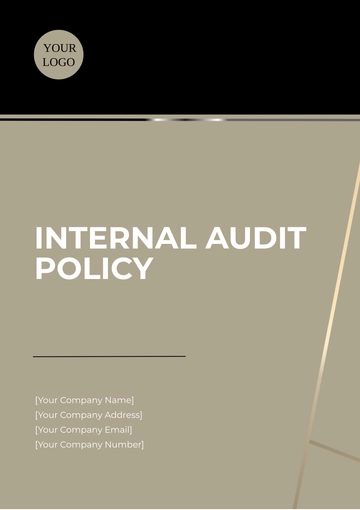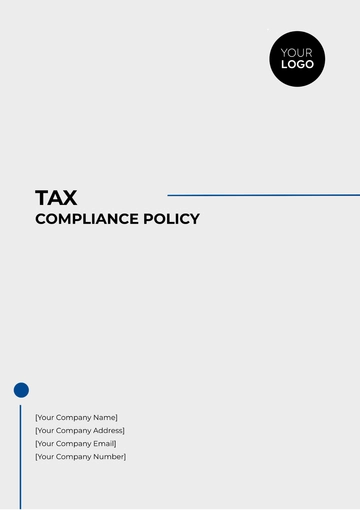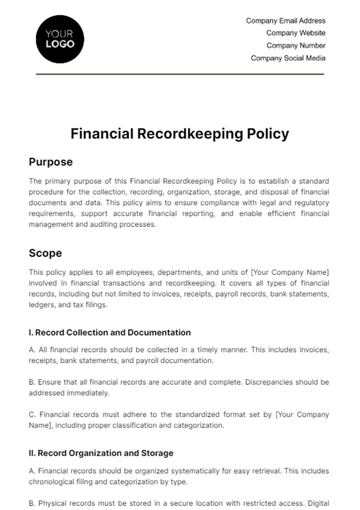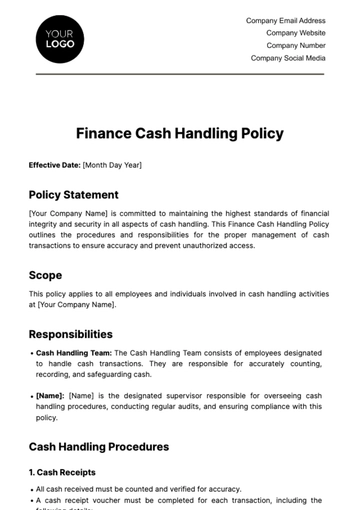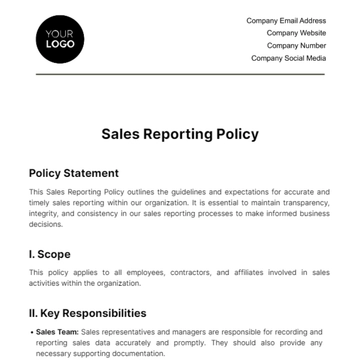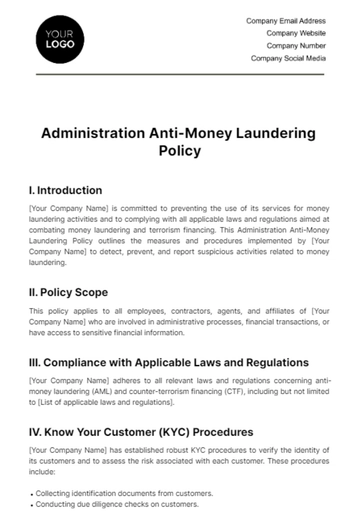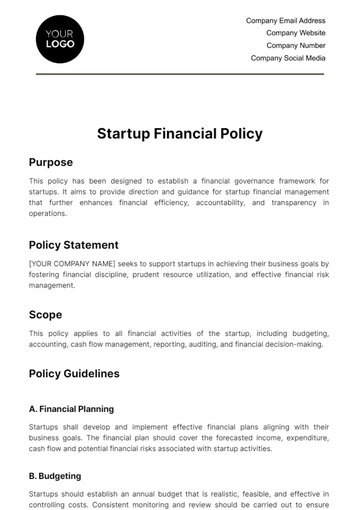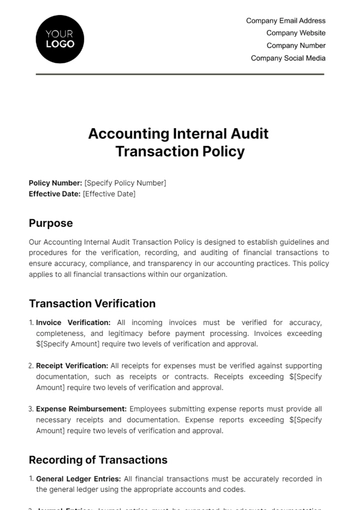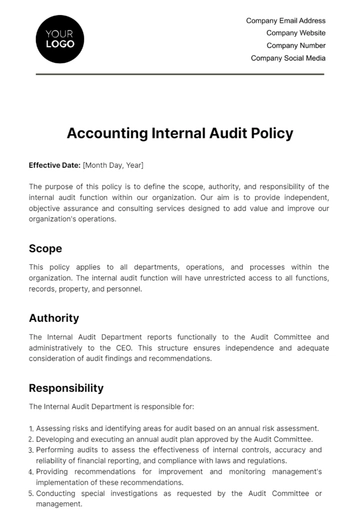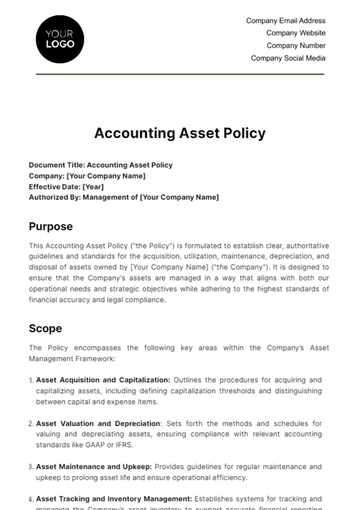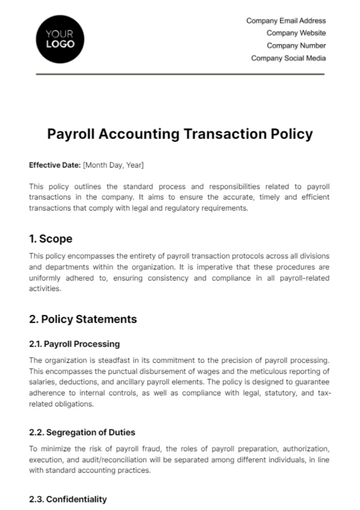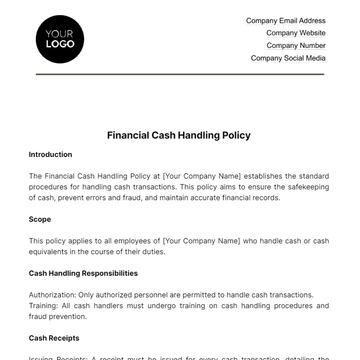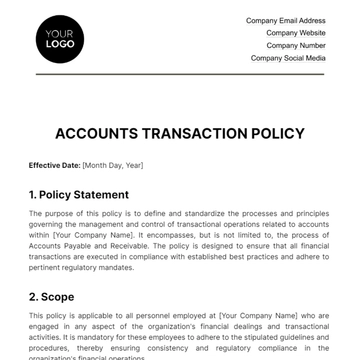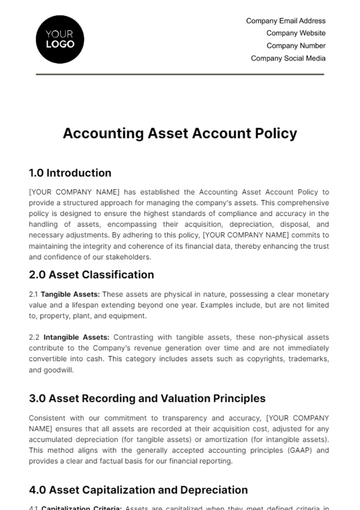Free Finance Policy

I. Purpose
The purpose of the Finance Policy at [Your Company Name] is to establish a robust framework for managing financial resources efficiently and effectively. This policy outlines the principles and procedures for budgeting, financial reporting, and internal controls, ensuring that all financial operations are conducted in a manner that promotes transparency, accountability, and compliance with applicable laws and regulations. By adhering to this policy, [Your Company Name] aims to safeguard its assets, maintain financial stability, and support its strategic objectives.
This policy also serves to guide employees in their financial activities, promoting consistency and accuracy in financial reporting and transactions. It ensures that financial practices align with industry best practices and legal requirements, thereby mitigating risks associated with financial mismanagement. Through regular reviews and updates, [Your Company Name] will adapt to evolving financial standards and regulatory changes, maintaining a strong financial position and fostering trust among stakeholders.
II. Scope
This section introduces the scope of the Finance Policy at [Your Company Name], defining the boundaries and applicability of the policy across various areas of the organization. It ensures that the policy is uniformly applied to all relevant financial activities and personnel, providing a clear framework for managing financial resources effectively. By delineating the scope, [Your Company Name] aims to ensure comprehensive and consistent adherence to financial standards and regulations throughout the company.
Scope:
All financial transactions and activities within [Your Company Name]
Employees involved in financial planning, budgeting, and reporting
Departments handling financial data, including Accounting, Finance, and Treasury
Financial audits and internal controls
Compliance with federal, state, and local financial regulations and standards
III. Budgeting
Effective budgeting is critical to the financial health and strategic success of [Your Company Name]. This section outlines the procedures and responsibilities associated with the preparation, review, and approval of the annual budget. The budgeting process ensures that resources are allocated in alignment with the company’s strategic objectives, financial goals, and operational needs.
A. Budget Preparation
The budget preparation process involves careful planning and analysis to ensure each department’s financial needs align with [Your Company Name]’s strategic goals. Departments are required to:
Analyze past performance: Departments review historical data, economic conditions, and future goals.
Draft detailed budgets: Departments prepare budgets with justified expenses and strategic alignment.
Submit to finance: Departments submit the finalized budgets to the finance department by the deadline.
Provide support tools: The finance department offers guidance and tools for consistency.
B. Budget Approval
Below are the steps for budget approval:
Review by Finance Committee: The committee reviews departmental budgets for accuracy and alignment with strategic goals.
Consolidation: The finance committee consolidates all departmental budgets into a single organization-wide budget.
Submission to Board: The consolidated budget is submitted to the Board of Directors for approval.
Final Approval: The Board’s approval confirms the budget as the guiding financial framework for the fiscal year.
IV. Accounting
The accounting practices at [Your Company Name] are designed to ensure accurate financial reporting, maintain compliance with relevant laws and regulations, and support sound financial decision-making. This section outlines the key accounting principles and procedures that govern the recording, management, and reporting of financial data within the organization. Adherence to these practices is essential for maintaining the integrity of [Your Company Name]’s financial records and ensuring transparency and accountability in all financial matters.
A. Financial Record Keeping
Accurate and timely financial record-keeping is the foundation of sound accounting practices at [Your Company Name]. All financial transactions must be recorded promptly and accurately in the company's accounting system. This includes income, expenses, assets, liabilities, and equity transactions. Each transaction should be supported by appropriate documentation, such as invoices, receipts, contracts, and bank statements. Departments are required to maintain these records in accordance with Generally Accepted Accounting Principles (GAAP) and ensure that all entries are properly classified and reconciled regularly.
B. Financial Reporting
The finance department is responsible for preparing and distributing accurate and timely financial reports that reflect the company’s financial position and performance. These reports include the balance sheet, income statement, cash flow statement, and other relevant financial documents. Financial reports should be prepared on a monthly, quarterly, and annual basis, following GAAP and other applicable accounting standards. The finance department must ensure that these reports are reviewed and approved by senior management and the Board of Directors before dissemination.
C. Internal Controls
Internal controls are essential for safeguarding [Your Company Name]’s assets and ensuring the accuracy and reliability of financial data. The company implements a robust system of internal controls that includes segregation of duties, authorization and approval procedures, access controls, and regular audits. Segregation of duties ensures that no single individual has control over all aspects of any significant financial transaction, thereby reducing the risk of fraud or errors. Authorization and approval procedures require that all financial transactions be reviewed and approved by designated personnel before processing. Access controls limit access to financial systems and data to authorized individuals only. Regular internal and external audits are conducted to assess the effectiveness of internal controls and identify areas for improvement.
D. Compliance with Laws and Regulations
[Your Company Name] is committed to complying with all applicable federal, state, and local laws and regulations related to accounting and financial reporting. The finance department is responsible for staying informed about changes in accounting standards and regulations and ensuring that the company's accounting practices are updated accordingly. This includes compliance with tax laws, financial reporting requirements, and any other relevant legal obligations. Non-compliance can result in significant penalties and damage to the company’s reputation, so strict adherence to legal and regulatory requirements is a priority.
V. Financial Reporting
At [Your Company Name], financial reporting is a cornerstone of our commitment to transparency, accountability, and informed decision-making. Accurate and timely financial reports provide crucial insights into the organization’s financial health, enabling management and stakeholders to make well-informed decisions that drive the company forward. These reports serve as a vital tool for monitoring performance, identifying trends, and ensuring that financial practices align with the company’s strategic goals.
The financial reporting process is designed to meet the highest standards of accuracy and reliability, reflecting [Your Company Name]’s dedication to maintaining the integrity of its financial operations. By adhering to a structured reporting schedule, the organization ensures that all relevant parties receive the financial information they need to fulfill their responsibilities effectively.
Monthly financial reports shall be distributed to department heads.
Quarterly financial reports shall be presented to the finance committee.
Annual financial reports shall be shared with the Board of Directors and key stakeholders.
VI. Internal Controls
Internal controls are essential for safeguarding the organization's assets and ensuring the integrity of its financial records. The following internal control measures must be implemented:
Segregation of duties to prevent conflicts of interest.
Regular audits by an independent internal audit team.
Authorization requirements for significant financial transactions.
Periodic reconciliation of bank statements and financial records.
VII. Asset Management
Effective asset management is critical to the long-term sustainability and financial health of [Your Company Name]. Proper management of assets ensures that the organization maximizes the value derived from its investments, minimizes risks, and maintains accurate records for financial reporting and decision-making. This section outlines the key procedures and responsibilities related to the acquisition, tracking, and depreciation of assets, ensuring that all assets are managed in accordance with the organization’s policies and regulatory requirements.
A. Asset Acquisition
The acquisition of assets must follow [Your Company Name]’s established procurement policies and procedures to ensure that all purchases are necessary, cost-effective, and aligned with the organization’s strategic goals. Before acquiring any asset, the relevant department must conduct a needs assessment and cost-benefit analysis to justify the expenditure. This process includes identifying the specific needs the asset will fulfill, evaluating alternatives, and ensuring the purchase fits within the approved budget.
For capital expenditures, which typically involve significant investments in long-term assets, additional scrutiny is required. All capital expenditure proposals must be thoroughly reviewed by the finance department and submitted to the Board of Directors for approval. This ensures that significant investments align with the organization’s financial strategy and long-term objectives. The approval process includes a detailed review of the financial implications, including potential returns on investment, risks, and the impact on cash flow.
B. Asset Register
Maintaining an accurate and up-to-date asset register is essential for effective asset management. The finance department is responsible for overseeing the asset register, which serves as a comprehensive inventory of all assets owned by [Your Company Name]. The asset register should include detailed information about each asset, such as the purchase date, cost, location, condition, and any relevant identification numbers.
To ensure the accuracy of the asset register, it must be updated regularly, reflecting any acquisitions, disposals, or changes in asset condition. Regular audits of the asset register should be conducted to verify the existence and condition of assets and to ensure that all assets are accounted for. These audits help prevent asset mismanagement, loss, or theft, and provide assurance that the organization’s financial statements accurately reflect its asset holdings.
C. Depreciation
Depreciation is a key aspect of asset management that ensures the financial statements accurately represent the value of the organization’s assets over time. Assets must be depreciated systematically over their useful life, following the depreciation method specified by [Your Company Name]’s accounting policies. Common methods include straight-line depreciation, declining balance, and units of production, depending on the nature of the asset and its expected usage.
Depreciation expenses are recorded in the organization’s financial statements, impacting the reported net income and asset values. The finance department is responsible for calculating depreciation and ensuring it is accurately reflected in the financial records. Regular reviews of depreciation schedules are necessary to ensure they remain appropriate, especially when there are changes in asset usage, technological advancements, or market conditions. Adjustments to depreciation rates or methods may be required to reflect the true economic value of assets, ensuring that the financial statements provide a fair and accurate picture of the organization’s financial position.
By adhering to these asset management practices, [Your Company Name] ensures that its assets are effectively utilized, accurately recorded, and appropriately valued, supporting the overall financial stability and growth of the organization.
VIII. Procurement
The procurement process must be transparent, competitive, and aligned with the organization's strategic objectives. All purchases must follow the established procurement procedures, which include:
Solicitation of multiple bids for significant purchases.
Evaluation of bids based on predefined criteria.
Approval of procurement decisions by authorized personnel.
IX. Compliance and Review
Ensuring compliance with all applicable laws, regulations, and internal policies is a top priority at [Your Company Name]. The organization is committed to upholding the highest standards of integrity in all financial practices, which requires strict adherence to relevant legal requirements and industry standards. The finance department is responsible for monitoring compliance, implementing internal controls, and ensuring that all financial activities are conducted in accordance with established guidelines. Regular training and updates are provided to staff to keep them informed about changes in regulations and internal policies, reducing the risk of non-compliance.
In addition to ongoing compliance efforts, [Your Company Name] conducts regular reviews of its financial policies and procedures to identify areas for improvement and ensure they remain current with evolving regulatory landscapes. These reviews are led by the finance department in collaboration with internal audit teams and external advisors as needed. Any findings from these reviews are addressed promptly, with corrective actions implemented to strengthen the organization’s financial practices. By maintaining a proactive approach to compliance and regularly reviewing its financial operations, [Your Company Name] ensures that it remains in good standing with regulatory authorities and continues to operate with transparency, accountability, and financial integrity.
- 100% Customizable, free editor
- Access 1 Million+ Templates, photo’s & graphics
- Download or share as a template
- Click and replace photos, graphics, text, backgrounds
- Resize, crop, AI write & more
- Access advanced editor
Establish clear guidelines with our Finance Policy Template, available on Template.net. Fully customizable and editable, this template ensures your financial policies are precise and consistent. Editable in our AI Editor Tool to effortlessly tailor the content to your organization's needs, providing a solid foundation for financial governance.
You may also like
- HR Policy
- Restaurant Policy
- Company Policy
- Accounting Policies and Procedures
- Website Policy
- Privacy Policy
- Safety Policy
- School Policy
- IT and Software Policy
- Law Firm Policy
- Construction Policy
- Interior Design Policy
- Travel Agency Policy
- Education Academic Policy
- Security Policy
- Real Estate Policy
- Expense Policy
- Software Policy

